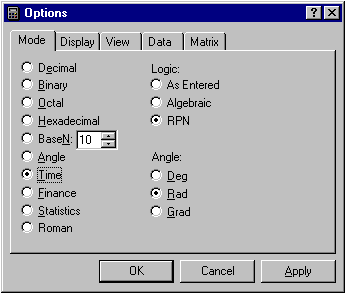Number Mode
Clicking the
Angle
Selecting one of the options in the Angle group determines how values of angles are interpreted when using the trigonometric functions.Mode
The Mode selection changes the number base between the many number modes available. Changing the Mode alters the legends on buttons which have functions specific to different number modes, or disables features which are not appropriate. The buttons which fall into this category have no legend. The way in which data is displayed also changes between various number modes.Changing number mode changes the calculator display, but any data stored in the calculator is retained. Therefore you can convert between different number systems by entering data and then selecting the new number base. However, only the decimal system has a decimal point, the other number bases work for integers only. Also note that a number in one system will require a larger number of digits in a lower number base, which may cause an overflow. This is especially likely when converting to binary.
When converting between different number modes it is sometimes inconvenient to keep going to the Mode dialogue. For quick Number Mode changes, either use the quick mode buttons on the fifth row of the function keypad, or use the accelerator or shortcut keys. These are all obtained by holding down Shift and Alt on the keyboard and typing the appropriate letter, i.e. D for Decimal, H for Hexadecimal, T for Time, etc. See the listing of keyboard accelerators.
There is a fifth row of function keys which allow you to quickly switch between modes. This is especially useful when working in multiple number bases. The fifth function keypad row is enabled by default when the software is installed but can be removed using the View tab of the options dialogue. Note that earlier versions used four rows of function keys and this will be picked up as the default, so you may need to explicitly set the number of rows to five.
Decimal
The format for display of decimal numbers is controlled by the Display Tab.Binary
Binary numbers and bit wise logic operators.Octal
Octal numbers and bit wise logic operators.Hexadecimal
Hexadecimal numbers and bit wise logic operators.Base-N
Arbitrary base numbers up to base 36. The base is set by an edit box adjacent to the BaseN radio button. For example, using a base of 10 gives decimal integers. For bases less than 10 the appropriate numeric buttons are enabled. For bases up to 16 (Hexadecimal) the letters A-F become progressively available.Beyond base 16 it is not practical to provide buttons for letters, and the computer keyboard must be used. The convention is for the upper case letter to be used (i.e. shifted letter).
An interesting example is base 36, where all the decimal digits and all the letters of the alphabet are available. In this case, words can be encoded and made the subject of computation. This gives interesting possibilities for word games and simple ciphers.
Example:
GADGET - 3ZS45L = CALC98
Convert to Decimal:
743385932
Statistics
Selecting statistics puts the calculator into statistics mode. This is the same as decimal mode except that the M+ button changes to Data for entering data values into the statistics memory. On pressing the shift button the AC(All Clear) button and some of the number buttons change to show the statistical functions. See the section on Statistics Functions for more information.Financial
Selecting financial mode enables the financial functions of the calculator. This also changes the precision of the display to show two decimal places, fixed point. See the section on Financial Functions for more information.Angle and Time
The Angle and Time modes allow display and input as sexagesimal numbers. In Time mode a stopwatch feature is also available.Roman
Roman numerals can be selected to display integers greater than zero. Note that zero is represented by a blank display. It is possible to perform calculations in Roman numerals, although in practice it is more likely you would want to convert to or from decimal numbers.Logic
Three types of operator precedence are offered; As Entered, Algebraic and RPN. In operator precedence the arithmetic operators are evaluated exactly in the order they are entered. For example, "1 + 2 * 3" evaluates to 9, because "1+2" is evaluated first, to give the result 3, which is then multiplied by 3. Simple calculators, typically used for financial calculations, often work this way.Scientific calculators use algebraic precedence where multiplication and division take priority over addition and subtraction, regardless of the order in which the expression is presented. In this case "1 + 2 * 3" evaluates to 7, because "2*3" is evaluated first, and the result added to 1. This is the default precedence for Calc98.
The single level of built-in algebraic precedence may not be sufficient for more complex expressions, and the solution is to use parentheses.
Users of RPN (Reverse Polish Notation) calculators are able to perform complex calculations without parentheses because each value can be pushed onto a "stack" and the operators applied in order. This elegant method was available in early Hewlett-Packard scientific models before calculators with parentheses became available. Many of the users of these calculators prefer to continue using RPN, so this has been added as a third precedence option.
In RPN mode some of the button legends and
behaviour change. In particular, the = button is labelled Enter
and is used to enter or push a value onto the stack. The Min and
MR
buttons become STO and RCL respectively. There are no parenthesis
buttons, but CLx and REG buttons are provided.